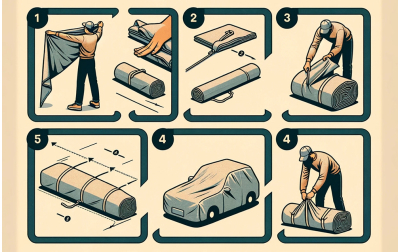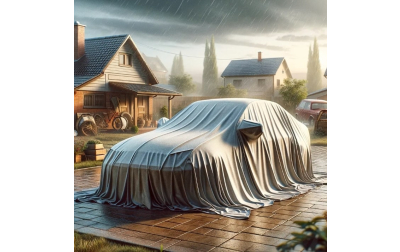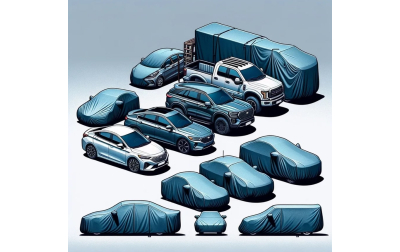
Can You Use a Car Cover on the Street? A Comprehensive Guide
Using a car cover on the street is more than just throwing a piece of fabric over your vehicle. It’s about making an informed decision to protect your vehicle from environmental hazards while avoiding potential pitfalls. This guide covers everything you need to know, including:
- Why Use a Car Cover on the Street? Learn about the risks of street parking and how a car cover can mitigate them.
- Answering the Question Directly Can you use a car cover on the street? Yes, but there are essential details to consider.
- Common Problems and How to Solve Them Discover the challenges of using car covers and practical solutions to overcome them.
- Legal Considerations Understand local regulations and how to comply while using a car cover on the street.
- Choosing the Right Car Cover for Street Use Tips for selecting a durable, weather-resistant, and custom-fit cover.
- Environmental Impact on Your Cover Learn how weather and pollution affect your cover and how to maintain it.
- Securing Your Car Cover Best practices for keeping your cover in place and deterring theft.
- Pros and Cons of Street Car Covers A breakdown of the benefits and drawbacks of using car covers on the street.
- Maintenance Tips for Long-Term Street Use How to keep your car cover clean and effective over time.
- When a Car Cover Isn’t Enough Additional measures to protect your car in extreme conditions or high-risk areas.
- Final Verdict A summary of everything you need to know to make the most of your car cover.
By the end of this guide, you’ll have all the tools and knowledge to protect your vehicle effectively, even in the challenges of street parking.
Why Use a Car Cover on the Street?
Street parking subjects your car to an onslaught of potential damage. Harsh UV rays can fade your paint, bird droppings and tree sap can corrode the finish, and falling debris can cause minor scratches. A car cover acts as a shield against these elements, preserving your car’s appearance and longevity.
However, not all covers are created equal. Thin, generic covers often fail to provide adequate protection and may even cause harm by flapping against your car’s surface during windy conditions. Opt for a high-quality, custom-fit cover designed for your vehicle’s make and model. These snug-fitting options minimize the risk of wind damage and ensure your car is well-protected.
Answering the Question Directly
So, can you use a car cover on the street? The answer is yes, but it comes with conditions. A properly selected and securely fastened cover is essential. Look for materials designed to withstand weather elements, such as UV-resistant and water-resistant fabrics. Additionally, consider theft-deterrent features like locking cables.
Don’t overlook legal requirements. Some cities enforce regulations that restrict car covers, particularly if they obscure license plates or make the vehicle appear abandoned. Check your local laws to avoid fines or potential towing.
Common Problems and How to Solve Them
Using a car cover on the street isn’t without challenges. Wind damage is a common issue. A loose cover can act like sandpaper, rubbing dirt and debris against your paint. To prevent this, select a cover with reinforced straps, tie-downs, or elastic hems to secure it tightly.
Theft is another concern. High-quality car covers are valuable and can attract thieves. Investing in locking cables that loop through the cover’s grommets and attach to your car’s undercarriage can deter theft.
Legal Considerations
Before using a car cover on the street, familiarize yourself with local regulations. In some areas, covering your car might lead to fines if the cover obstructs your license plate or gives the impression that your car is abandoned.
Many modern car covers solve this problem with transparent license plate windows or Velcro flaps. Ensuring your plate remains visible will help you stay compliant with local laws while still protecting your vehicle.
Choosing the Right Car Cover for Street Use
The right car cover makes all the difference when parking on the street. Multi-layered covers with UV protection, water resistance, and breathable fabrics are ideal. Breathability is crucial to prevent moisture buildup, which can lead to mold or rust.
Custom-fit covers, designed for your specific make and model, offer superior protection. Features like elastic hems, adjustable straps, and reinforced stitching enhance durability and reduce flapping in the wind. Brands that include theft-deterrent options, such as locking cables or built-in grommets, are especially valuable.
Environmental Impact on Your Cover
Street parking exposes car covers to wear and tear from elements like rain, snow, wind, and pollution. Even the best materials degrade over time, so regular maintenance is essential.
Clean your car cover every few weeks with mild soap and water to remove dirt and grime. Avoid harsh detergents, as they can strip protective coatings. Dry the cover thoroughly before reinstalling it to prevent mold or mildew.
Inspect your cover for signs of wear, such as thinning fabric or tears. When a cover starts to deteriorate, it’s time to replace it to ensure your vehicle remains fully protected.
Securing Your Car Cover
A poorly secured cover can do more harm than good. Wind gusts can cause flapping, leading to scratches or exposing parts of your car to the elements. Tie-down straps and built-in grommets are essential for a snug fit.
Theft is another consideration. High-quality car covers can attract attention, so investing in a locking cable system is wise. These cables loop through the cover’s grommets and secure to your vehicle, providing peace of mind.
Pros and Cons of Street Car Covers
Using a car cover on the street has clear benefits: protection from UV rays, bird droppings, tree sap, and light debris. It also safeguards your car against weather damage. However, there are downsides. A poorly chosen or improperly secured cover can cause scratches, invite theft, or lead to legal troubles. Balancing these factors with proper planning ensures maximum benefit.
Maintenance Tips for Long-Term Street Use
Street environments can be tough on both your car and its cover. Regular maintenance is key to ensuring your cover lasts. Clean it periodically to remove dust, dirt, and pollutants that can degrade its effectiveness. For machine-washable covers, use a gentle cycle with mild detergent.
Inspect for wear and tear, such as fraying edges or loose stitching, and replace the cover when necessary. A well-maintained cover will continue to protect your car effectively over time.
When a Car Cover Isn’t Enough
A car cover is an excellent first line of defense but may not suffice in extreme conditions. For areas prone to hail or heavy snow, consider padded covers that provide extra impact resistance. Adding wheel locks and a dash cam can further deter theft and vandalism.
Parking in a well-lit area enhances security for both your car and its cover. These additional measures provide peace of mind, especially in high-risk environments.
Final Verdict
Using a car cover on the street is a practical choice for protecting your vehicle, but it requires careful consideration. From selecting the right cover to ensuring compliance with local laws and maintaining the cover properly, attention to detail is crucial.
Investing in a high-quality cover tailored to your car’s make and model, combined with theft-deterrent measures and regular maintenance, will ensure your vehicle remains protected. While it takes more effort than garage parking, the benefits of using a car cover on the street far outweigh the challenges.
Frequently Asked Questions
1. Can you use any car cover for street parking?
Not all car covers are suitable for street parking. Thin, generic covers may flap in the wind and cause scratches or fail to protect against harsh weather. It’s best to use a custom-fit, weather-resistant car cover designed specifically for your vehicle’s make and model.
2. How do I prevent my car cover from being stolen?
To prevent theft, use locking cables that loop through the cover’s grommets and attach securely to your car’s undercarriage. These cables make it difficult for someone to remove the cover without a key or combination.
3. Can a car cover damage my car’s paint?
Yes, a poorly secured or low-quality cover can cause scratches, especially in windy conditions when the cover flaps and rubs against the car’s surface. Always use a custom-fit cover with tie-down straps or elastic hems to avoid this issue.
4. Is it legal to use a car cover on the street?
It depends on your local regulations. Some municipalities restrict the use of car covers if they obscure license plates or make the vehicle appear abandoned. Check local laws and ensure your license plate remains visible to avoid fines or towing.
5. What is the best material for a street car cover?
The best material for street car covers is multi-layered, weather-resistant fabric with UV protection, water resistance, and breathability. These features protect against sun damage, rain, and moisture buildup while reducing the risk of mold and rust.
6. How often should I clean my car cover?
You should clean your car cover every few weeks, especially if it’s exposed to dirt, bird droppings, or pollution. Use mild soap and water, and let it air dry thoroughly before reinstalling to avoid trapping moisture underneath.
7. Can a car cover protect against hail?
Some car covers are designed with padded layers to provide additional protection against hail. If you live in an area prone to hailstorms, invest in a cover specifically rated for impact resistance.
8. What should I do if my car cover tears or wears out?
Inspect your car cover regularly for signs of wear, such as tears, loose stitching, or thinning fabric. If you notice significant damage, replace the cover to ensure it continues to provide adequate protection.
9. Does a car cover protect against theft or vandalism?
While a car cover alone doesn’t prevent theft or vandalism, it can act as a deterrent by concealing the vehicle and making access more difficult. For added security, pair it with wheel locks, a dash cam, or parking in a well-lit area.
10. What should I look for in a car cover for extreme weather conditions?
For extreme weather, choose a car cover with padded layers for impact resistance, multi-layered waterproof material, and reinforced stitching. These features provide additional protection against heavy rain, snow, hail, and debris.
















